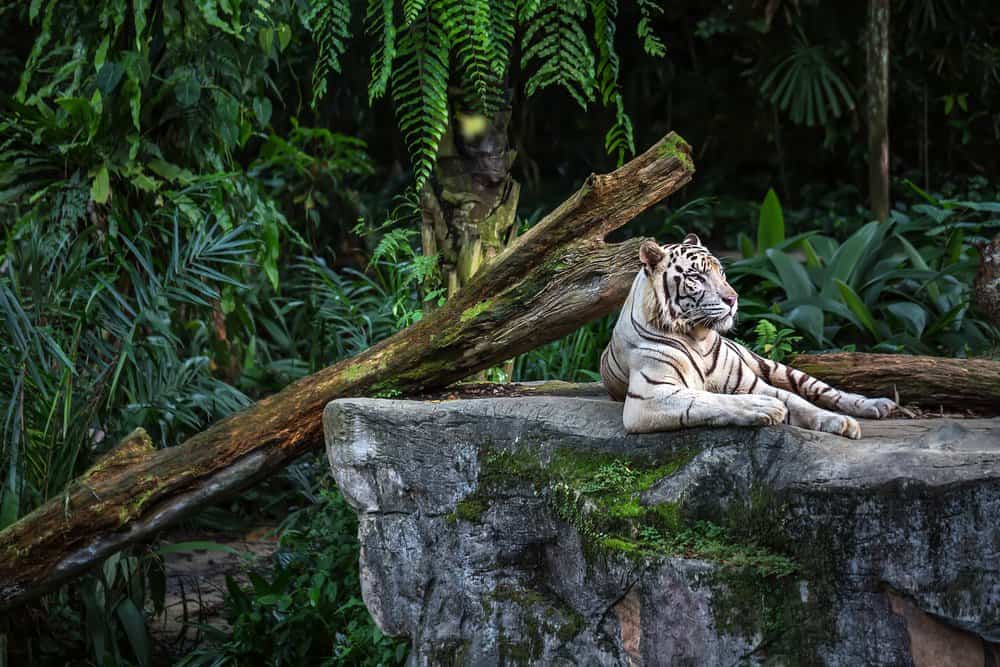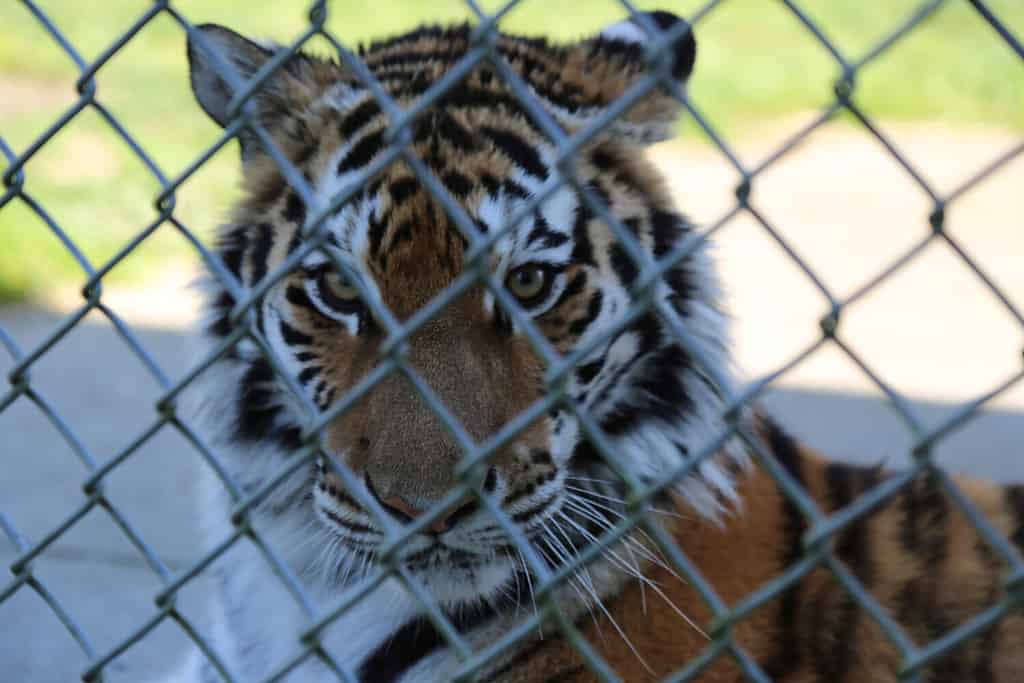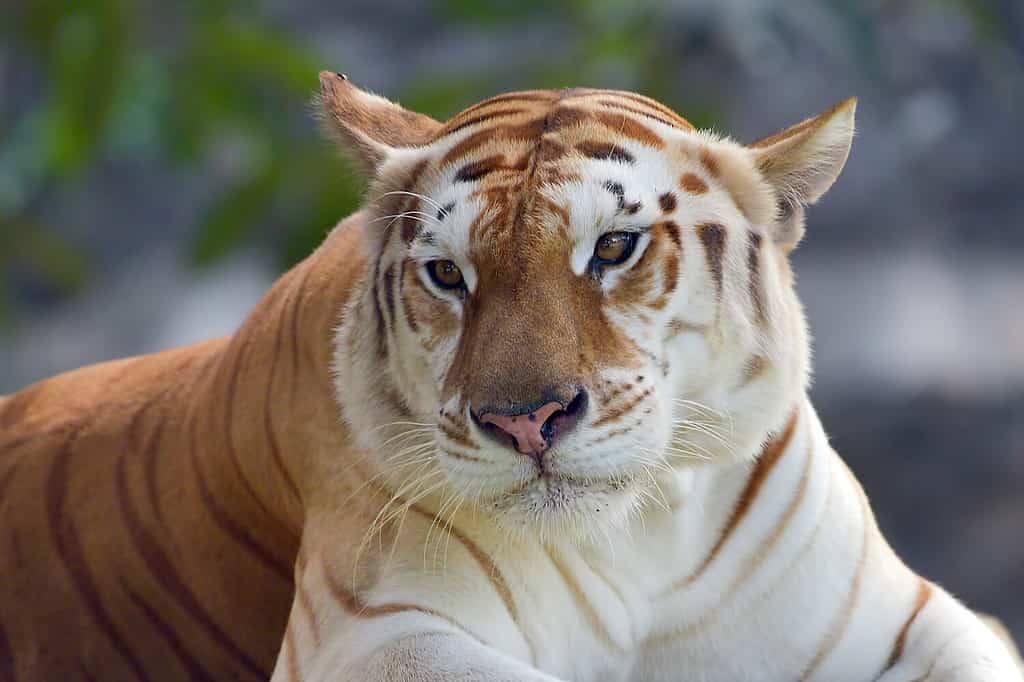If beauty were to decide the jungle king, the white tiger would be among the leading contestants. This rare member of the Bengal subspecies has a white fur coat graced with the regular black stripes, making it one of the most sought-after animals in the world. The breed’s rarity poses many questions to the world and has birthed a curiosity in many. This article quenches that curiosity by providing ten incredible white tiger facts.

1. The White Tiger Is Not A Separate Subspecies Of Tiger

White tigers are not a natural subspecies.
©bezikus/Shutterstock.com
Although some try to brand the white tiger as a subspecies of tiger, it is not. There is only one species of tiger and two subspecies – the continental tiger and the Sunda tiger.
2. The White Tiger Is A Product of Genetic Mutation

The white coat of a white tiger is a product of a recessive gene in both parents that becomes dominant.
©S.K Photos/Shutterstock.com
The white tiger looks the way it does due to genetic mutation. Usually, a tiger has the base orange color and the black stripes to match. The orange color results from pheomelanin, which unfortunately is absent in the white tiger. The white striped coat is a product of a recessive gene in both parents that becomes dominant in the cub. By default, these cubs are born without the orange striped color but a white or pale cream coat.
3. White Tiger Birth In The Wild Is Very Rare

1 in 10,000 wild tiger births results in a white tiger.
©PlasticTV, CC BY-SA 3.0, via Wikimedia Commons – License
A white tiger’s birth is only possible in the wild when both tiger parents carry the recessive gene that causes the condition. This, however, is a challenging possibility as this case is only possible in 1 out of 10000 births. With these figures, it’s clear to see why the white tiger is a rare breed.
4. The White Tiger Is Indigenous To India

India is the place of origin for white tigers.
©Tatohra/Shutterstock.com
The white tiger was initially found in the Indian subcontinent. The first sighting of the animal was in 1951 in India. The cub was domesticated and groomed to be a pet and was named Mohan. Mohan was believed to be used for breeding many white tigers sent around the world, making it the patron white tiger.
5. There Are No White Tigers In The Wild

You will only find white tigers in zoos and other places of captivity.
©Muhammad Mahdi Karim / Creative Commons – License
As of today, there are no white tigers in the wild. The last time one was sighted in the wild was 50 years ago. The low probability of them existing is one explanation. However, there is another reason: captivity. All white tigers alive are in captivity as people use them in zoos, parks, and sanctuaries to make money.
6. The White Tiger’s Coat Is A Disadvantage

The white tiger has a color that is easily detectable and scares off all prey before it gets close enough.
Although the white coat looks incredibly beautiful on the white tiger, it is a disadvantage in the wild. The tiger depends on its orange skin color to succeed while hunting. The skin camouflages with its environment making it possible for them to practice their surprise attack. On the other hand, the white tiger has a color that is easily detectable and scares off all prey before it gets close enough.
There are, however, reports that the white tiger can hunt successfully at night. While its fur can look very bright, it has been noticed that the white tiger grows darker when it is exposed to the cold. This happens while tigers spend most of their time outdoors during the winter.
7. White Tigers Are Amongst The Most Exploited Animals In The World

Many other tigers are also kept in somewhat exploitative conditions.
©Apsara Photo/Shutterstock.com
While most animals are kept in captivity to protect them, this is not true for the white tiger. The white tiger would be worth protecting if it were a subspecies, but this is not the case. It is just like the spirit bear, a black bear with a condition similar to that of the white tiger. Its rarity has made it a sight to behold, which is why many zoos try to have more white tigers, as they are a commercial sales point. Tigers with this rare condition are held captive worldwide and used to make money.
8. White Tigers Are Only Multiplied Through Inbreeding

Many white tigers have birth defects.
©Eric Isselee/Shutterstock.com
Due to their rarity and the desire to have more of them, keepers of these tigers have resorted to inbreeding. They cross mothers with sons, fathers with daughters, and brothers with sisters. While the births happen, there are deformity issues, a normal repercussion of inbreeding. Most white tigers are thus born with deformities like club feet, cleft palates, spinal deformities, and defective organs.
9. The White Tiger Is Not The Only Tiger Mutant

Golden tigers are also known as strawberry tigers.
©DSlight_photography/Shutterstock.com
While it’s a popular variation, the white tiger is not the only mutant in the species. There are other mutant tigers, including:
- The Golden Tiger
The golden tiger is also known as the golden tabby tiger or strawberry tiger. It has a golden color coat with black stripes.
- The Black Tiger
This mutant tiger has more stripes, almost overshadowing its base orange color.
- The Blue Tiger
This mutant tiger is also known as the Maltese tiger. It is native to the Fujian province in China and has bluish fur with dark stripes.
10. White Tigers Have Other Traits Not Seen In Regular Tigers

White tigers have blue eyes.
Apart from the white fur coat, other differences can be spotted in the white tiger. One significant difference is in their eyes. These white tigers are born with blue eyes, which are not seen in the regular tigers. It is worth mentioning that color does not influence their vision.
Also, they usually have crossed eyes which become more apparent when stressed. This phenomenon has been observed in many mutant cats and seems to be a part of the mutation. Another difference is in size. The white tiger is usually bigger than the regular Bengal tiger. Cubs born white are usually larger than normal and have a faster growth rate than other tiger cubs.
The photo featured at the top of this post is © mgnovenia/Shutterstock.com
Thank you for reading! Have some feedback for us? Contact the AZ Animals editorial team.






